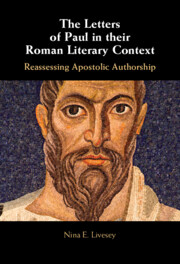Book contents
- The Letters of Paul in their Roman Literary Context
- The Letters of Paul in their Roman Literary Context
- Copyright page
- Dedication
- Contents
- Preface
- Acknowledgments
- Note on the Text
- Abbreviations
- Introduction
- 1 The Press toward the Authentic-Letter Perspective
- 2 Paul, Pauline Communities, and Genuine Correspondence
- 3 Seneca’s Moral Epistles and Pauline Letters as Teachings
- 4 Pauline Letters as Second-Century School-Setting Compositions
- Epilogue
- Appendix
- Bibliography
- Index
1 - The Press toward the Authentic-Letter Perspective
Published online by Cambridge University Press: 05 December 2024
- The Letters of Paul in their Roman Literary Context
- The Letters of Paul in their Roman Literary Context
- Copyright page
- Dedication
- Contents
- Preface
- Acknowledgments
- Note on the Text
- Abbreviations
- Introduction
- 1 The Press toward the Authentic-Letter Perspective
- 2 Paul, Pauline Communities, and Genuine Correspondence
- 3 Seneca’s Moral Epistles and Pauline Letters as Teachings
- 4 Pauline Letters as Second-Century School-Setting Compositions
- Epilogue
- Appendix
- Bibliography
- Index
Summary
Through a broad history of the interpretation of Pauline letters, the chapter highlights a difference between their earliest understanding as authoritative and scripture-like, and Enlightenment readings when they became valued for their historical worth. Both during and following the Enlightenment, issues surrounding the letters became relevant, such as authorship, provenance, language style, and social-political context. In addition, scholars like F.C. Baur and others mined the letters they deemed authentic for what they might reveal about Early Christianity. Yet the methodologies adopted to assess a letter’s authenticity (authorship) and historical reliability were variously flawed and very often circular, with the result that the scholarship reified a subjective an and unsubstantiated history. Criteria of authenticity reveal Pauline favoritism. The interpretation of Pauline letters as genuine correspondence can be attributed in large part to the flawed interpretation of the nineteenth-century scholar Adolf Deissmann. While rejecting Deissmann’s underlying and determinative rationale, NT scholars nonetheless carried forward his overall assessment of the letters as genuine correspondence.
- Type
- Chapter
- Information
- The Letters of Paul in their Roman Literary ContextReassessing Apostolic Authorship, pp. 31 - 72Publisher: Cambridge University PressPrint publication year: 2024

